The Intel Broadwell Desktop Review: Core i7-5775C and Core i5-5675C Tested (Part 1)
by Ian Cutress on June 2, 2015 7:45 AM ESTGaming Benchmarks: Mid-Range
Shifting gears, let's take the iGPU out of the equation and look at gaming from a CPU perspective, By moving up to higher-end video cards, we can being to see how Broadwell stacks up in CPU-bound gaming scenarios.
Alien: Isolation
If first person survival mixed with horror is your sort of thing, then Alien: Isolation, based off of the Alien franchise, should be an interesting title. Developed by The Creative Assembly and released in October 2014, Alien: Isolation has won numerous awards from Game Of The Year to several top 10s/25s and Best Horror titles, ratcheting up over a million sales by February 2015. Alien: Isolation uses a custom built engine which includes dynamic sound effects and should be fully multi-core enabled.
For low end graphics, we test at 720p with Ultra settings, whereas for mid and high range graphics we bump this up to 1080p, taking the average frame rate as our marker with a scripted version of the built-in benchmark.
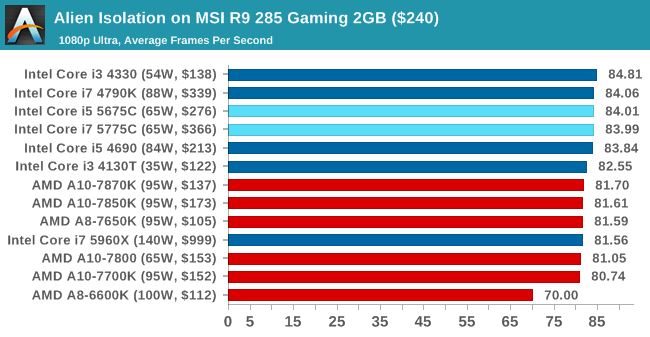
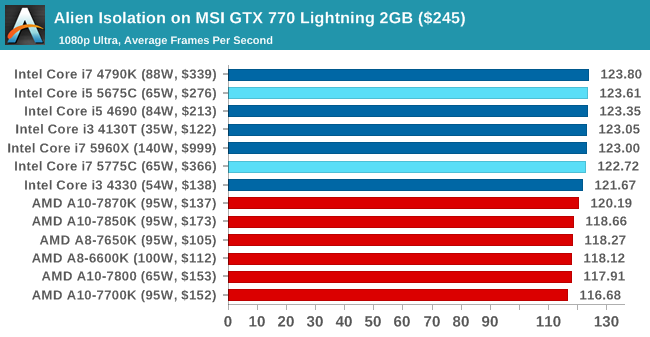
Total War: Attila
The Total War franchise moves on to Attila, another The Creative Assembly development, and is a stand-alone strategy title set in 395AD where the main story line lets the gamer take control of the leader of the Huns in order to conquer parts of the world. Graphically the game can render hundreds/thousands of units on screen at once, all with their individual actions and can put some of the big cards to task.
For low end graphics, we test at 720p with performance settings, recording the average frame rate. With mid and high range graphics, we test at 1080p with the quality setting. In both circumstances, unlimited video memory is enabled and the in-game scripted benchmark is used.
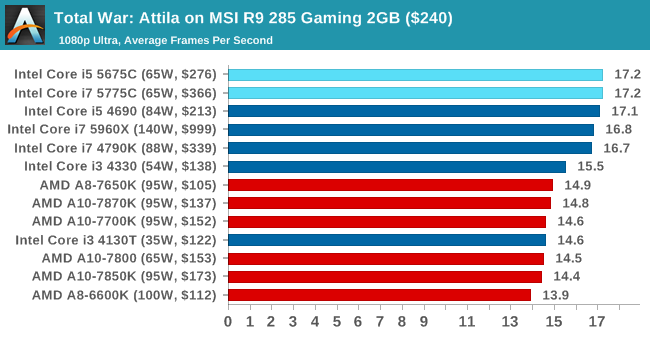
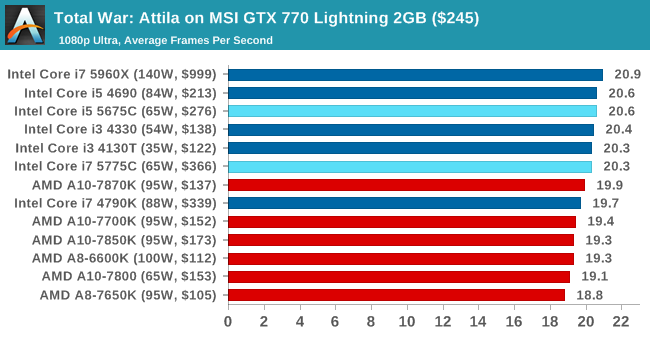
Grand Theft Auto V
The highly anticipated iteration of the Grand Theft Auto franchise finally hit the shelves on April 14th 2015, with both AMD and NVIDIA in tow to help optimize the title. GTA doesn’t provide graphical presets, but opens up the options to users and extends the boundaries by pushing even the hardest systems to the limit using Rockstar’s Advanced Game Engine. Whether the user is flying high in the mountains with long draw distances or dealing with assorted trash in the city, when cranked up to maximum it creates stunning visuals but hard work for both the CPU and the GPU.
For our test we have scripted a version of the in-game benchmark, relying only on the final part which combines a flight scene along with an in-city drive-by followed by a tanker explosion. For low end systems we test at 720p on the lowest settings, whereas mid and high end graphics play at 1080p with very high settings across the board. We record both the average frame rate and the percentage of frames under 60 FPS (16.6ms).
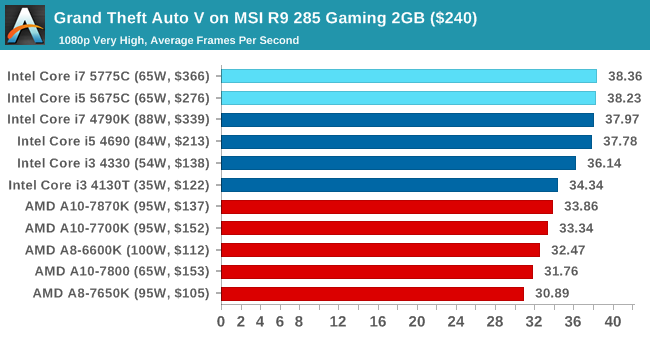
![Grand Theft Auto V on MSI R9 285 Gaming 2GB ($240) [Under 60 FPS]](https://images.anandtech.com/graphs/graph9320/74957.png)
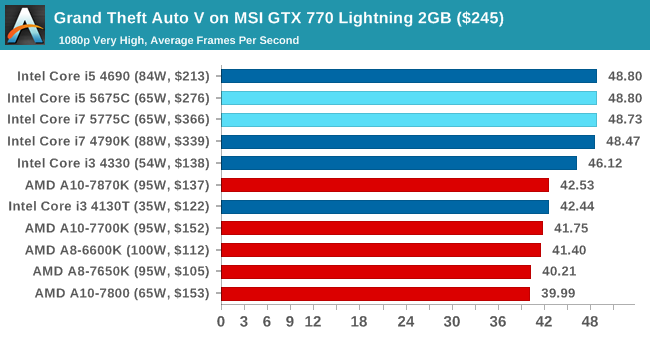
![Grand Theft Auto V on MSI GTX 770 Lightning 2GB ($245) [Under 60 FPS]](https://images.anandtech.com/graphs/graph9320/74967.png)
GRID: Autosport
No graphics tests are complete without some input from Codemasters and the EGO engine, which means for this round of testing we point towards GRID: Autosport, the next iteration in the GRID and racing genre. As with our previous racing testing, each update to the engine aims to add in effects, reflections, detail and realism, with Codemasters making ‘authenticity’ a main focal point for this version.
GRID’s benchmark mode is very flexible, and as a result we created a test race using a shortened version of the Red Bull Ring with twelve cars doing two laps. The car is focus starts last and is quite fast, but usually finishes second or third. For low end graphics we test at 1080p medium settings, whereas mid and high end graphics get the full 1080p maximum. Both the average and minimum frame rates are recorded.

![GRID: Autosport on MSI R9 285 Gaming 2GB ($240) [Minimum FPS]](https://images.anandtech.com/graphs/graph9320/74959.png)
Middle-Earth: Shadows of Mordor
The final title in our testing is another battle of system performance with the open world action-adventure title, Shadows of Mordor. Produced by Monolith using the LithTech Jupiter EX engine and numerous detail add-ons, SoM goes for detail and complexity to a large extent, despite having to be cut down from the original plans. The main story itself was written by the same writer as Red Dead Redemption, and it received Zero Punctuation’s Game of The Year in 2014.
For testing purposes, SoM gives a dynamic screen resolution setting, allowing us to render at high resolutions that are then scaled down to the monitor. As a result, we get several tests using the in-game benchmark. For low end graphics we examine at 720p with low settings, whereas mid and high end graphics get 1080p Ultra. The top graphics test is also redone at 3840x2160, also with Ultra settings, and we also test two cards at 4K where possible.
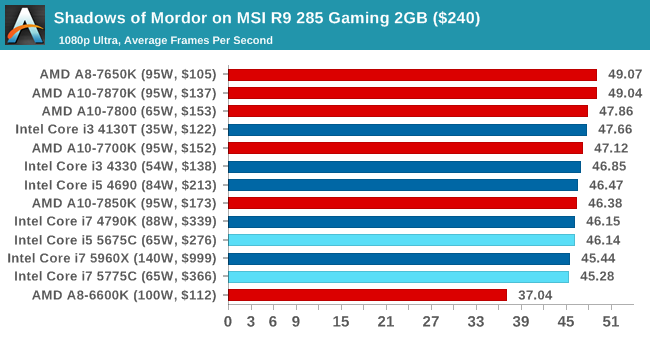
![Shadows of Mordor on MSI R9 285 Gaming 2GB ($240) [Minimum FPS]](https://images.anandtech.com/graphs/graph9320/74961.png)
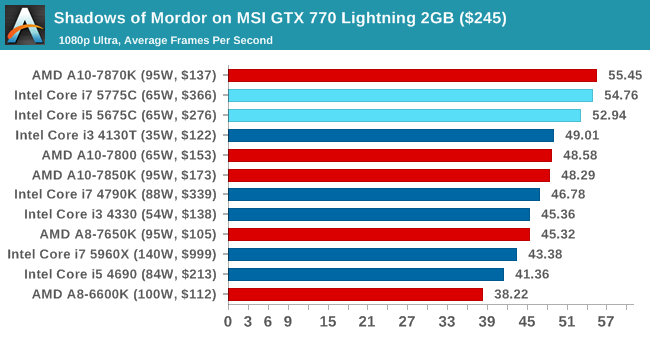
![Shadows of Mordor on MSI GTX 770 Lightning 2GB ($245) [Minimum FPS]](https://images.anandtech.com/graphs/graph9320/74971.png)
Shadows of Mordor at 4K, Single GPU
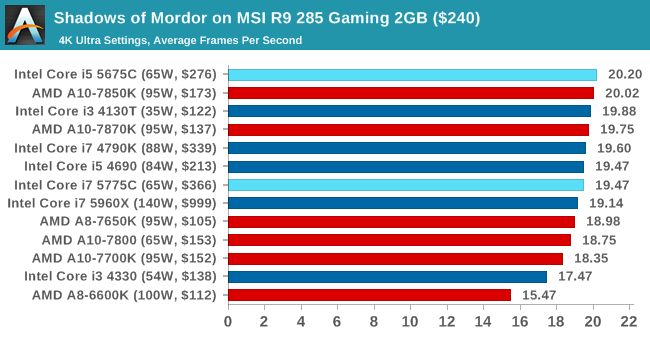
![Shadows of Mordor on MSI R9 285 Gaming 2GB ($240) [Minimum FPS]](https://images.anandtech.com/graphs/graph9320/74963.png)
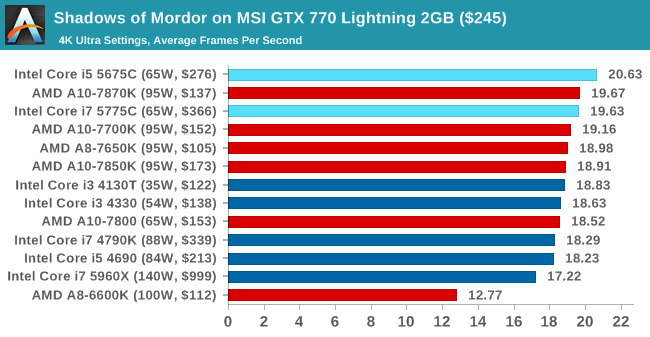
![Shadows of Mordor on MSI GTX 770 Lightning 2GB ($245) [Minimum FPS]](https://images.anandtech.com/graphs/graph9320/74973.png)
Conclusions on Mid-Range Graphics
With the Intel iGPU removed from the picture, what we're seeing here is the combination of Broadwell's architecture improvements, and the Crystal Well eDRAM functioning as an L4 cache for the CPU cores. The biggest benefit here Broadwell-DT was with the R9 285 for GRID on minimum frame rates, showing 75.6 for the 4790K vs 80.06 for the 5775C. Otherwise performance overall is not all that different from what we already see with the best Haswell CPUs, however it's a bit surprising that the Broadwell CPUs don't fall behind, given their rather sizable frequency deficit versus the i7-4790K.















196 Comments
View All Comments
Taneli - Tuesday, June 2, 2015 - link
So how does it compare to 4770R?IUU - Tuesday, June 2, 2015 - link
Good , very good . Now after they have succeeded in this exercise, that is , showing they can build decent igpu, they can finally proceed to the real goal. Make a little bit weaker processors with the same igpu for real laptops, where portability but performance as well are needed at the same time.Then, throw away the burden of the i-gpu part for real desktop parts and complete the desktop series with 80 100 and 130 watts models.
Trying to persuade customers that from now on this is the high end is not going to work. The desktop
or desktop like derivatives should be at the front end of new computer challenges, none of which is
what we describe today as consumer needs(with the exception of gaming of course which admit it or not will always be one of the most demanding software).
Consider that pattern recognition(be it sound video or logic-language) will demand a lot of and parallel processing. Trying to push it as a network based service will not succeed at least as it is
envisioned right now. A significant part of it should be done locally. Now take this advice and conquer or abandon it and fail lol...
bill.rookard - Tuesday, June 2, 2015 - link
I'm not sure that they've proven they can build a decent iGPU. The whole point of integrated graphics is to provide an affordable solution with 'good enough' performance. While they have certainly hit the 'good enough' performance from both a CPU and GPU point of view, they've entirely missed the 'affordable' part of things. For the price of a single Intel CPU, you can almost get an AMD -system- which (while about 10% slower on average) is no small matter.Truth is (as pointed out) you can get an AMD chip with a $100 discrete graphics card which would blow either of the iGPUs away.
mrdude - Tuesday, June 2, 2015 - link
That's the issue both AMD and Intel have had with respect to their iGPUs. Once you've dedicated enough of the die to GPU transistors and skirted around the memory bottleneck (at least for Intel), you end up with a product that, while offering decent GPU performance, is horrendously overpriced for what it offers. Outside of niche scenarios, these things just don't make much sense given just how performance even cheap discrete GPUs can offer.I'd like to see what Intel's margins are on these parts and how much the eDRAM adds to the overall cost of the product. If yields are good and prices aren't much higher, I'd love to see Intel 'bite the bullet' in order to replace the entire product portfolio top-to-bottom. They'd benefit massively from it with respect to market share and being taken seriously with their gaming endeavor.
Unfortunately, I don't think Intel is willing to eat lower margins and a dip in profits for a long term gain, even if it would see a bucking of the current dip in sales with uptick in systems sold.
Refuge - Tuesday, June 2, 2015 - link
They have the best margins in the business.But of course they wont. Why lower prices, make less money now, kill AMD more, and then make more money later possibly if you don't lose out on some BS legal battle over having no compitition. Because it will happen, you know it will.
When instead you can continue to enjoy your large margins with minimal griping because the blame is being split between Intel's greed and AMD's inability to compete. Watch them die slowly, make more money while doing it. They control this playing field, why rock the boat when it is more profitable than it should be already?
Kjella - Tuesday, June 2, 2015 - link
And an Intel chip too, I wonder who are these people who'll pay $276-366 for something that'll get totally trashed by a $64 G3260 + $2-300 discrete graphics card. I guess the target market is AIOs that value style and low power consumption over performance and cost. If you look at their laptop prices, they're the same. So I'm guessing Intel didn't want manufacturers underclocking the 65W chips and using them as cheap 47W laptop chips. And the AIO makers wouldn't like Intel releasing a socketed chip cheaper than the identical BGA chip so the price is set with no grounding to reality in the desktop market.vision33r - Tuesday, June 2, 2015 - link
Majority of people can use G3260 + a decent vid card and have no clue it's a cheap underclass cpu. i5 and i7 are just marketing ploy for clueless people to buy the top level even though they don't know where the performance bottlenecks really are.Notmyusualid - Thursday, June 4, 2015 - link
You know, two of my brothers have i5 CPUs, and my i7 utterly trounces them, in every way. I was expecting the difference to be small, but oh no, for example, one brothers' 3230M does wPrime in < 19s, my i7 < 8s.This speed difference is reflected in the way the PCs 'feels' in every way. I'd say i7's are worth the money, despite seeing some i5s offer up great benchmarks online...
If gaming, then yes, you need an actual decent gpu, but for everything else, CPU counts most...
xulmar - Saturday, June 6, 2015 - link
Are you joking? 3230M? Obviously in laptops the story is different. In desktop the i5 and i7 are comparable, as the i7's main advantage is only the HT, but they still got 4 physical cores all the same. Laptop i5s are crippled processors. If intel would offer an i5 with 4 phsyical cores at a reasonable price - i'd buy it instantly. But 2+2 cores vs 4+4 in laptop i7 is hella difference. Obviously the processor can only be half as fast in multithreaded, if its only HALF of the i7... If you care even a bit about performance in a laptop, i7 is a no brainer, and sadly Intel is pushing the prices up, and replacing the middle class with the U processors which will sadly ruin everyone's dreams about reasonably priced PC performance in the future. This leaves an opportunity for AMD, as soon a quad i7 will be unavailable in any laptop under 1000 dollars...Namisecond - Wednesday, June 3, 2015 - link
"I wonder who are these people who'll pay $276-366 for something that'll get totally trashed by a $64 G3260 + $2-300 discrete graphics card."The same people who don't treat gaming benchmarks as the sole reason for their purchase. Once you get out of gamer culture, you'll find people value (whether mistakenly or not) CPU power over GPU power. In the corporate IT world, installing that $100 discrete GPU card can cost more than the hardware alone.